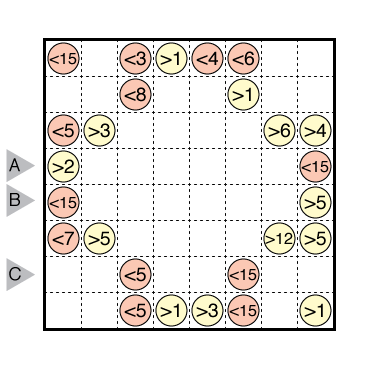Araf (Inequality) by Dan Katz

or solve online (using our beta test of Penpa-Edit tools with a composite mode for line/edge drawing.)
Theme: Clue Symmetry and Logic
Author/Opus: This is the 1st puzzle from guest contributor Dan Katz.
Rules: Divide the grid into some regions formed of edge-adjacent squares. Each cell is part of one region, and each region should contain exactly two given numbers, one in a yellow circle (>) and one in a red circle (<). Each region must have an area that is strictly between those numbers. Note: This idea to "simplify" Araf puzzles comes from Prasanna Seshadri, whose example of this variation will appear tomorrow. Answer String: Enter the number of cells in each connected group (between bold lines) in the marked rows. Separate the rows with a comma.
Time Standards (highlight to view): Grandmaster = 1:20, Master = 3:00, Expert = 6:00
Solution: PDF
Note: Araf is a relatively new puzzle for us on GMPuzzles. Follow this link for other Araf. An example image for a “classic” Araf puzzle is here.

I’m not sure about how you would rate the difficulty of the Araf puzzles here so far, but I felt I solved this using logic more than the one yesterday which felt a little like I lucked it, and guessed an answer. I like this format more
6:05
I find this presentation kind of weird. To me it reads like the numbers in the circles have to be either higher or lower than the given number. The name Inequality also seems to hint at this for me.
I think it’s just easier to call it high/low or something hinting to the real idea of the colours, where yellow numbers are always the lowest number in the area and red numbers always the highest number in the area. That way you can also only colour part of the numbers as it’s instantly implied that an area can contain one yellow or one red number.
The inequality symbols are primarily there for those who may print without color, or who may forget the sense of high and low in the puzzle. And the numbers are still defining the polyomino shape size, so the inequalities work the same way they would in a Fillomino puzzle if I put a < N clue into a cell. Of course I know this description won't completely satisfy. This was one of the hardest puzzles to find any format people would like. It went through about 4 presentation changes in testing because there was nothing that would satisfy everyone. I'm convinced there still isn't. One other comment was that instead of a clue like <6 I should change this to <= 5 as that was the intended meaning. That is reasonable in a world without Araf, and it may be that trying to make this presentation closer to the presentation we use for "Classic" Araf leads to more trouble than it is worth.
I figured that would be the reason. It’s just that I can’t really think of any other puzzle type they are used in this way. Maybe you can use squares and circles for a colourless printing format or black and white circles.
My preferred shape variation (which was in the experimented with set of formats) was left and right facing triangles that were clearly distinct shapes, but also had a < and > shape to them. Up and down facing triangles would have worked too. But ultimately some of the very large clues didn’t fit well into those shapes. When it got to using just two distinct shapes to be color friendly I was not as enthused with the direction things were going.
02:13.
I also have the same complaint as Para; when I first looked at it, I wondered about the same thing. Although of course, for black-and-white printers, differentiating by color only, especially as light as those, is kind of evil. I’d suggest giving something like 2+ and 4- to indicate 3 (although it might suggest the bounds are inclusive), or 2- and -4 (as in between 2 and 4, but that again might be weird)…
As per the puzzle itself, it flows nicely. There was some kind of global logic required, but it means a nice thing for me. Nice puzzle.
The clues feel very redundant here. Almost 50% of the givens in this puzzle could be replaced with just the inequality signs (“< 15" or "< 40" or simply " 1” or just “>”). With only “> 2” in r6c7 and r5c8, the “> 5” in r6c8 and the other givens replaced with “< 15" (or " 1” all given circles could be paired up.
By replacing only “> 12” in r6c7, the “> 5” in r6c2, the “> 2” in r4c1 and either “> 6” in r3c7 or “< 6" in r1c6 the puzzle can be solved.
Some parts of my post got lost, where it says ” 1″ I meant > 1